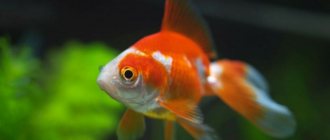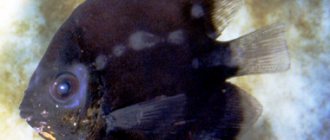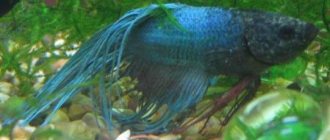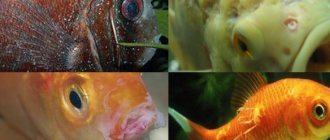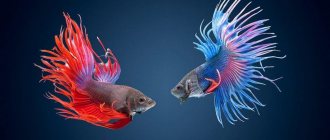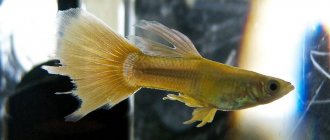Floats belly up
The fish is alive and breathing rapidly, and the abdomen increases in size. If a goldfish swims belly up, the animal is prone to obesity and is vulnerable to infections that lead to swim bladder problems. Reasons why fish swim on their back:
- Monotonous food.
- Binge eating. Sprinkle food 1-2 times a day in pinches, which your pets can eat in a couple of minutes. Remove any leftover food immediately. If the fish systematically overeats, put it on a hunger strike for 3 days, after which you feed it green peas without skin.
- Excess protein feed. Goldfish are herbivores. The carp food system does not break down animal proteins. Feed your pets a balanced goldfish food, and occasionally serve scalded lettuce, peas, broccoli or cucumbers. Live and frozen foods make up 20–30% of the diet, plant foods – 70–80%.
- Dropsy is a common disease in golden carp. It is characterized by swelling, due to which the pet turns over with its stomach up. Check the water parameters and the amount of nitrites, change the liquid if necessary and change the parameters. Transplant the sick individual into a separate aquarium. Mix chloramphenicol with food (250 mg per 25 g of food) or dissolve the antibiotic in water (10 mg per 1 liter).
- Diseases. Place your sick pet. Check the concentration of nitrites and ammonia, examine the animal. Determine why your goldfish swims unnaturally. Swimming with your belly up is one of the signs of mycobacteriosis (tuberculosis). Other signs: swelling of the abdomen, floating near the surface, bulging eyes, curvature of the spine, fading of color, desire to hide. Symptoms appear in different combinations. The disease is rarely treatable. Change the water daily for 2 weeks, add kanamycin (30 mg per 1 liter).
Lies at the bottom
Goldfish lie at the bottom of the aquarium for various reasons:
- Stress. The recently acquired goldfish is not used to the new aquarium and lies or hides among the shelters. Observe your pet for a couple of days. The situation will not change in case of illness. Make sure that there are no constant sources of stress in the aquarium such as overcrowding or pugnacious neighbors.
- Lack of free space. Golden carp should be kept in an aquarium with a volume of at least 40–50 liters, depending on the specific variety.
- Poisoning. Rare water changes and malfunctioning filters lead to contamination.
- Heat. Goldfish are comfortable at 18–22 degrees. If you don't have a thermometer, purchase one. Glass and electronic thermometers show results with less error.
- Alkalosis or acidosis are diseases caused by improper pH. Goldfish are kept at a pH of 6–8. If the parameters do not correspond, smoothly align them to acceptable values. Other signs of these diseases: protruding fins, convulsions, lack of coordination, restless behavior, and fading of color.
- Injuries caused by unfriendly neighbors.
- Ichthyophthiriasis (“semolina” or “white spot disease”). Other signs: the goldfish itches against objects in the aquarium, loses appetite, becomes lethargic, hides, breathes quickly, and white specks are visible on the body. Treat your goldfish with medications from a pet store based on malachite green according to the instructions. An alternative is biomycin (1.4 g per 100 l). Apply 1-2 times a week, increasing aeration.
- Mycobacteriosis.
View this post on Instagram
Posted by Irishka Spirina (@sp_irina_kzn) Sep 30, 2021 at 3:49 PDT
Drugs for the treatment of ichthyophthyriosis
Today there are many drugs for the treatment of ichthyophthyriosis. By and large, their composition is the same: a mixture of malachite green with various substances - formaldehyde, methylene blue, furatsilin, brilliant green.
- Anti-steam (when used in a general aquarium, requires constant monitoring of hydrochemistry);
- Sera Omnisan (good for the initial form of ichthyophthyriosis);
- Aquarium Pharmaceuticals (available in liquid and capsule form);
- JBL Punktol ULTRA (for advanced forms, it is recommended to combine with JBL Ektol crystal);
- Sera Omnisan + Micopur (excellent against tropical forms of ichthyophthyriosis);
- Sera Costapur; Tetra Contralck.
Swordtail Sanke care and maintenance
Turned white
Color change is a natural phenomenon for goldfish up to 2 years old. As the temperature drops, pets become paler. The color is also influenced by the shade of the primer; white primer leads to a natural lightening of the color. Strange behavior and paleness are caused by diseases and improper maintenance:
- Ichthyophthyriasis.
- Insufficiently nutritious food.
- "Cotton disease." The animal behaves restlessly, itches, and plaque or growths resembling cotton wool appear on the body. Eliminate sources of stress, check water parameters. Use products containing phenoxyethanol.
- Costiosis. Accompanied by loss of appetite, itching, and the appearance of a white or gray coating. Introduced with infected individuals and live food. Treat with copper sulfate (1 g per 10 l), place the goldfish in the solution for 10 minutes. Repeat the procedure for 5 days. Treatment with salt is acceptable. Immerse the goldfish in the bath (25 g per 10 l) for 15 minutes. in a week.
Main symptoms of goldfish diseases
There are a number of symptoms that should alert you:
- cloudy or enlarged eyes;
- change in scale color;
- red spots on the fish (or any other color);
- problems with appetite;
- chaotic movements of the fish;
- white plaque and mucus;
- redness of the gills;
- rotten areas on the body;
- swollen belly;
- peeling of skin;
- the appearance of papillomas, growths, etc.
All these signs indicate the presence of diseases that need urgent treatment. Before buying fish, it is advisable to study possible diseases and their symptoms in advance in order to notice the problem in time.
The tail is peeling
Damage to the tail indicates diseases:
- Fin rot. In goldfish, red veins appear, the edges become smaller, and the fins may turn black. Place the golden carp in a bath of salt water (1 teaspoon per 3 liters) for half an hour. Carry out the procedure once a day for a couple of weeks. The use of preparations based on malachite green and methylene blue is effective.
- Flexibacteriosis (columnaria). Appears in dirty and too warm water. The initial stage of the disease is treatable. In addition to discoloration of the tail with subsequent destruction, ruffling of the scales in the tail part, paleness of the edges of the scales, lightening of the mouth area and stiffness of movements are observed. Immerse the goldfish in baths with a pinkish solution of potassium permanganate for 10–15 minutes for 3–5 days. You can use chloramphenicol (50 mg per 3 l), adding it every other day for a week. After this, add kanamycin (1 g per 20 l) according to a similar scheme.
Columnaria
“Mouth fungus” occurs due to improper feeding patterns, overcrowding in the aquarium and high levels of organic matter. A characteristic sign is a swollen area under the gills, but without bulging eyes or ruffling of scales.
In addition, the following signs indicate columnaria:
- dark coating on the gills;
- general lethargy of the fish, which constantly wants to hide;
- no reaction to stimuli;
- blurred eyes;
- mouth lesions;
- altered swimming pattern (worm-like movements);
- refusal of food.
The insidiousness of this disease is that symptoms as such may be completely absent, which leads to untimely treatment.
Betta fish should be treated with antibiotics of the tetracycline group: tetracycline, metacycline and doxycycline. In some cases, it is necessary to combine doxycycline and Biseptol.
The scales fall off and fall off
Goldfish scales fall off as a result of:
- Excess nitrites. Change the water and add conditioners.
- Neighborhood with catfish. Sticky catfish damage the scales. Sometimes the problem is solved by increasing the amount of plant food, but it is better to spread out the pets.
- Lepidorthosis. In certain areas of the body, scales rise and fall out. The disease is introduced with aquarium animals that have not undergone quarantine and soil from natural reservoirs. Treat carp with biomycin (1.4 g per 100 l), adding the solution weekly for a month. You can use baths with basic purple. Prepare a stock solution (100 mg per 1 liter), dilute 10–15 ml of the resulting solution in 10 liters of water. Place the sick individual in the solution for 4 days.
- Ichthyosporidiosis. Illness is indicated by intermittent swimming, convulsions, lying on the bottom on one side, heavy breathing, bulging eyes, loss of scales and bruising. The disease is difficult to cure. Dilute phenoxytol in water in a ratio of 1:100. Pour the resulting solution into the aquarium (10–20 ml of solution per 1 liter) for 2 weeks.
- Tuberculosis. In golden carps, a sign of mycobacteriosis is loss of scales without ruffling.
Quarantine for illnesses
If you bought an aquarium, take care of a spare tank with a volume of 40-50 liters with mandatory aeration. You need to move a sick fish into it, even if it is not infectious, but simply injured. It costs very little to feed. Antibacterial and vitamin preparations (potassium permanganate solution, tea tree oil, special Sera Fishtamin vitamins) are added to the isolation tank. Quarantine lasts up to 2 weeks. If the fish takes on its usual color, swims calmly, its scales shimmer, and there is no damage, rot or mucus, you can return the pet “home.”
Fins have turned black
Darkening of fins is caused by:
- Poisoning with nitrogenous compounds. The body is covered with black spots, the animal breathes rapidly and stays near the surface. Increase aeration and change up to 30% of the water. Adding conditioners that neutralize harmful compounds will help. Restart the aquarium. If there are few or no plants in the aquarium, plant them. The soil layer must be at least 5 cm.
- Fin rot.
Growth on the head
There are breeds of goldfish with a “cap” on their heads (oranda, red cap, pearl with a crown). The growth appears at 3–4 months, sometimes unexpectedly for the aquarist. If you have a golden carp of another breed, the formation on the head is caused by:
- The appearance of a tumor. It cannot be treated, but under good conditions the animal will live a long time.
- Trauma.
- Unsuitable conditions.
Red spots
Causes of red spots:
- Rubella is a collective name for spring viremia of carp, aeromonosis, pseudomonosis and vibriosis - diseases with similar manifestations. Accompanied by hemorrhages, especially in the head area. Other signs: the appearance of ulcers, bulging eyes, swelling of the abdomen. Carry out treatment in a separate container. You will need leukocyte human interferon (1 ampoule per 35 l) in combination with chloramphenicol (2.5 g per 100 l). Apply every other day until the condition improves. Replace a third of the water at least 1-2 times a week. Chloramphenicol (250 mg per 25 g of feed) or furazolidone (0.5 g per 25 g of feed) also helps. Feed the mixture for 6 days. Provide continuous aeration during treatment.
- Skin and gill flukes. Animals behave restlessly, try to scratch themselves on objects, fins are often pressed, red spots appear on the body, and the skin becomes covered with mucus. Treat with special means against parasites or using baths with potassium permanganate.
- Ammonia poisoning.
Eyes bulging
Bulging eyes and the appearance of a whitish coating on the eyes accompanies the following diseases:
- ichthyosporidiosis;
- rubella;
- tuberculosis.
Examine the skin and fins, observe the behavior of the inhabitants of the aquarium. Check water parameters. Changes in one eye usually indicate injury.
Causes
The causes of non-communicable diseases are:
- Injuries or mechanical damage.
- Incorrectly formulated diet or overfeeding.
- Overpopulation of the aquarium.
- Influence of external factors (filter or compressor failure).
- Overheating or hypothermia of water.
The above factors for the development of non-contagious diseases depend on the owner, so when you get aquarium fish, it is important to monitor the conditions in which your pets are kept and care for the small creatures.
Die
Be responsible when cleaning your aquarium. You should know the water parameters and check it with tests. If your goldfish dies, immediately remove the deceased pet from the tank and inspect the other inhabitants of the aquarium. Before getting a fish, get acquainted with the features of starting a reservoir, feeding, compatibility and maintenance of the aquarium. Goldfish die for the following reasons:
- water pollution;
- unsuitable conditions;
- no quarantine for new fish;
- neglect of processing of feed and plants;
- overfeeding

